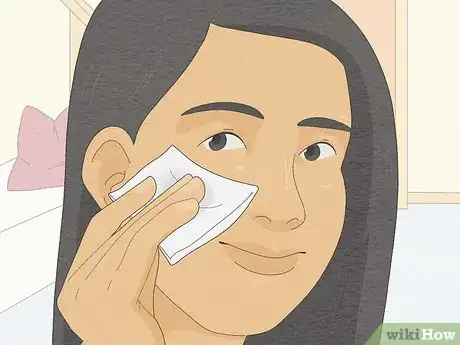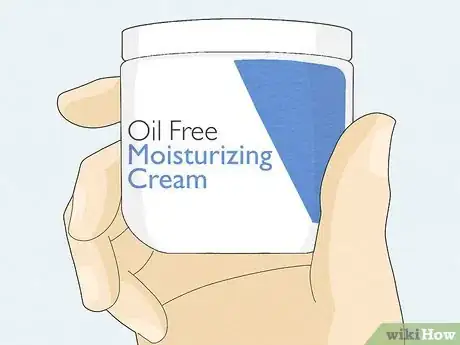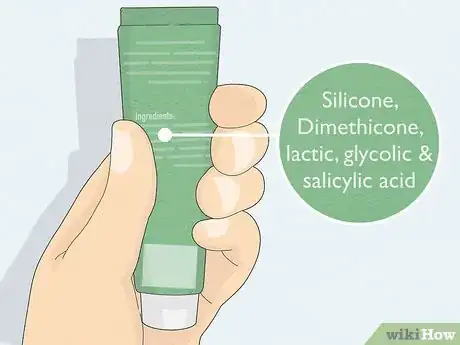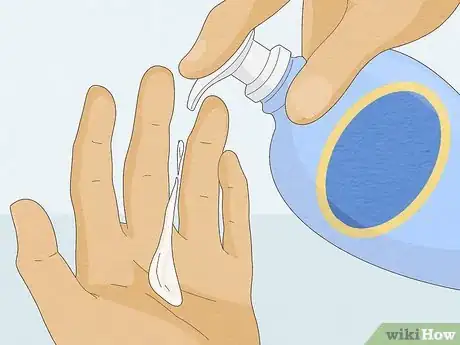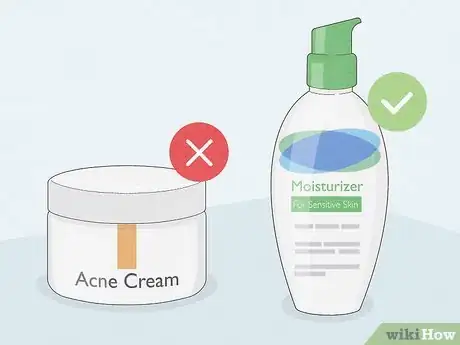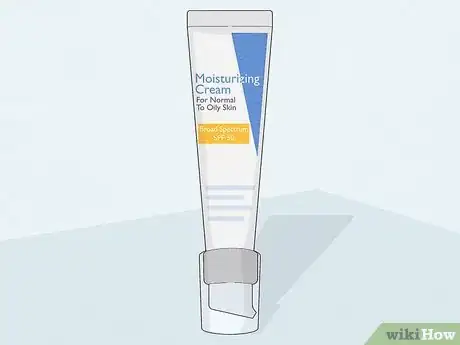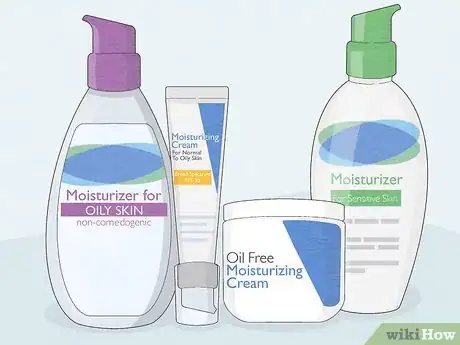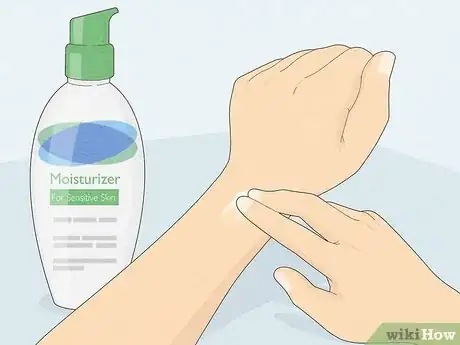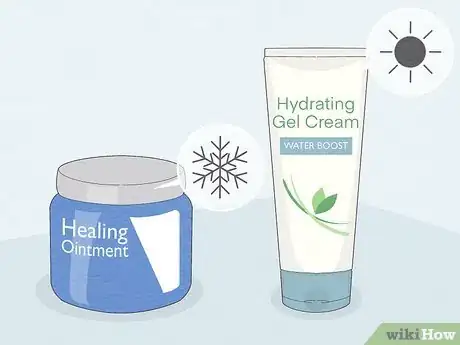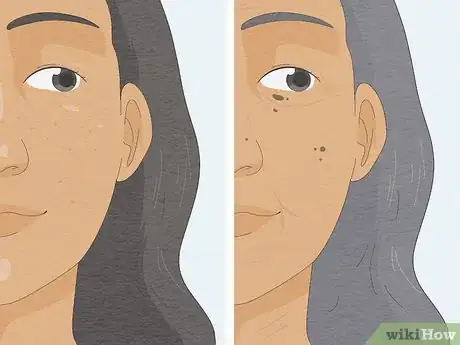This article was medically reviewed by Luba Lee, FNP-BC, MS. Luba Lee, FNP-BC is a Board-Certified Family Nurse Practitioner (FNP) and educator in Tennessee with over a decade of clinical experience. Luba has certifications in Pediatric Advanced Life Support (PALS), Emergency Medicine, Advanced Cardiac Life Support (ACLS), Team Building, and Critical Care Nursing. She received her Master of Science in Nursing (MSN) from the University of Tennessee in 2006.
There are 10 references cited in this article, which can be found at the bottom of the page.
This article has been viewed 246,391 times.
If you have oily skin, you may feel that moisturizer is your enemy, but this is a mistake. Believe it or not, moisturizer can actually help cut down on visible grease and shine. Without it, your skin will become dehydrated, and it will overcompensate by producing even more oil. This does not mean, however, that all moisturizers will work equally well for you. Make sure you choose a moisturizer specially made for your skin type and don't be afraid to try multiple products until you find one that works best for you.
Steps
Determining How Oily Your Skin Really Is
-
1Rule out problematic products. Don’t assume you have naturally oily skin just because it appears shinier than you would like. You might just be using the wrong product.[1]
- It’s possible that the moisturizer you are using is too heavy. When you use a product that is too rich for your skin, your pores can’t absorb it. As a result, the product sits on your skin, potentially clogging your pores.
- Conversely, you might actually be using a product that is too harsh and drying. Your skin compensates for these products by producing more oil.
- Stick to gentle cleansers and light, oil-free moisturizers for a few weeks to see how your skin reacts.
-
2Observe where and when your skin is oily. All people have natural oils in their skin, but this does not mean that everyone should use products developed for oily skin. Once you have ruled out products as the culprit, consider the following when determining where you stand:[2]
- If your skin is oily throughout the day and you have large pores all over your face, you probably have oily skin.
- If oily skin and large pores exist only in your T-zone (the forehead, nose, and chin), you probably have combination skin.
- If you only see oily skin in your T-zone when the weather is warm, you probably have normal skin.
- If your skin is oily but your pores are small, it’s a good sign that your products, and not your skin type, might be to blame.
Advertisement -
3Do a tissue test. Wash your face with a gentle cleanser, and don’t put anything on top of it. In an hour or two, blot with a tissue. If you see greasy splotches, your skin is probably oily. If not, you probably have combination skin.[3]
-
4Determine a course of action. If you determine that your skin is not really oily, look for a moisturizer for normal skin. On the other hand, if you have truly oily skin, look to Part 2 for help choosing the right product.
Choosing the Right Products
-
1Read the label. Moisturizers designed for oily skin will often include key words like water-based, non-comedogenic (won’t clog pores), non-acnegenic (won’t cause acne) and/or oil-free.[4]
- Oil-free products are more complicated than you think, however, as they may contain other ingredients that can clog your pores (like waxes) or irritate your skin (like alcohol).[5]
-
2Examine the ingredients. People with oily skin should be on the lookout for the ingredients that can both help and harm their skin.
- Water-based products should have a word than ends in “-icone” (like silicone) as one of the first few ingredients.[6]
- Dimethicone is often used as a replacement for petrolatum, which is oil-derived. Dimethicone is both moisturizing and mattifying, which means that it can help control grease and shine.[7]
- Look for exfoliating ingredients. Oily skin can often be dull and thick, so choose products with ingredients that will aid in cell turnover. These include lactic, glycolic, and salicylic acid.[8]
- Avoid products that include paraffin, cocoa butter, or oils.[9]
-
3Think about texture. Moisturizers come in many different forms. From lightest to heaviest, these include gels, lotions, and creams. Keep in mind their different properties when choosing.[10]
- People with oily skin should avoid creams and heavy lotions.
- Instead, choose gels or light lotions.
-
4Consider the other products you use. Oily skin can also be acne-prone, which means that you might be using harsh and drying anti-acne products. Don’t irritate your skin further by layering anti-acne moisturizer on top of these products. Instead, look for moisturizer for sensitive skin.
- If you’re not using other anti-acne products, moisturizers that also fight breakouts might be a good bet for you.
-
5Look for SPF. Experts recommend that you look for a moisturizer that also protects your skin from the sun. Many people with oily skin worry that sunscreen will exacerbate greasiness and shine, so again look for products that claim not to clog pores or cause acne.[11]
- You might also want to consider using sunscreen as moisturizer. Sunscreen hydrates your skin, so you might want to skip a second layer, especially if your skin is oily. (If you wear both, put on sunscreen first.)[12]
Experimenting with Products
-
1Shop around. You want a moisturizer that leaves your skin hydrated but not greasy, fresh but not tight. It might take you a little while before you find a product that matches your particular skin. Since you might have to try a few different products before you find the right one, don’t think that you have to buy the most expensive brand. Cheaper options can often work just as well.[13]
-
2Test new products on your arm first. To avoid breakouts and rashes, test moisturizer on your arm before using it on your face. This is especially important for people whose skin is also sensitive. Unless you have an immediate reaction, try to wait two weeks before deciding if the product is right for you.[14]
-
3Vary your routine with the seasons. Your skin will not behave the same all year long, so consider using a different moisturizer in summer and winter.[15]
- As long as your skin is not acne-prone, even those with oily skin may want to consider using an ointment in winter.
- Similarly, those with normal and combination skin may want to switch to a lighter lotion or gel during the summer months, when their skin may be oily.
-
4Think about your age. Oily skin does not exist in a vacuum. A fifteen-year-old who is dealing with oily skin and acne will need different products from a forty-year-old who might want to fight aging, as well.[16]
Expert Q&A
-
QuestionIs lacto calamine good for oily skin?
 Luba Lee, FNP-BC, MSLuba Lee, FNP-BC is a Board-Certified Family Nurse Practitioner (FNP) and educator in Tennessee with over a decade of clinical experience. Luba has certifications in Pediatric Advanced Life Support (PALS), Emergency Medicine, Advanced Cardiac Life Support (ACLS), Team Building, and Critical Care Nursing. She received her Master of Science in Nursing (MSN) from the University of Tennessee in 2006.
Luba Lee, FNP-BC, MSLuba Lee, FNP-BC is a Board-Certified Family Nurse Practitioner (FNP) and educator in Tennessee with over a decade of clinical experience. Luba has certifications in Pediatric Advanced Life Support (PALS), Emergency Medicine, Advanced Cardiac Life Support (ACLS), Team Building, and Critical Care Nursing. She received her Master of Science in Nursing (MSN) from the University of Tennessee in 2006.
Board-Certified Family Nurse Practitioner Lacto calamine is a great product for daily moisturizing. It has other additional benefits such as evening out skin tone, decreasing pimples and increasing skin healing.
Lacto calamine is a great product for daily moisturizing. It has other additional benefits such as evening out skin tone, decreasing pimples and increasing skin healing. -
QuestionHow can I tell if my skin is oily?
 Luba Lee, FNP-BC, MSLuba Lee, FNP-BC is a Board-Certified Family Nurse Practitioner (FNP) and educator in Tennessee with over a decade of clinical experience. Luba has certifications in Pediatric Advanced Life Support (PALS), Emergency Medicine, Advanced Cardiac Life Support (ACLS), Team Building, and Critical Care Nursing. She received her Master of Science in Nursing (MSN) from the University of Tennessee in 2006.
Luba Lee, FNP-BC, MSLuba Lee, FNP-BC is a Board-Certified Family Nurse Practitioner (FNP) and educator in Tennessee with over a decade of clinical experience. Luba has certifications in Pediatric Advanced Life Support (PALS), Emergency Medicine, Advanced Cardiac Life Support (ACLS), Team Building, and Critical Care Nursing. She received her Master of Science in Nursing (MSN) from the University of Tennessee in 2006.
Board-Certified Family Nurse Practitioner See this WikiHow article on How to Know Skin Type here: http://www.wikihow.com/Know-Skin-Types
See this WikiHow article on How to Know Skin Type here: http://www.wikihow.com/Know-Skin-Types -
QuestionWhat is the best time to moisturize oily skin?
 Luba Lee, FNP-BC, MSLuba Lee, FNP-BC is a Board-Certified Family Nurse Practitioner (FNP) and educator in Tennessee with over a decade of clinical experience. Luba has certifications in Pediatric Advanced Life Support (PALS), Emergency Medicine, Advanced Cardiac Life Support (ACLS), Team Building, and Critical Care Nursing. She received her Master of Science in Nursing (MSN) from the University of Tennessee in 2006.
Luba Lee, FNP-BC, MSLuba Lee, FNP-BC is a Board-Certified Family Nurse Practitioner (FNP) and educator in Tennessee with over a decade of clinical experience. Luba has certifications in Pediatric Advanced Life Support (PALS), Emergency Medicine, Advanced Cardiac Life Support (ACLS), Team Building, and Critical Care Nursing. She received her Master of Science in Nursing (MSN) from the University of Tennessee in 2006.
Board-Certified Family Nurse Practitioner Moisturizers should be applied in the morning and at night after a thorough cleansing of your face. The best time for application is after a bath or shower. Day-time moisturizer should contain sunblock.
Moisturizers should be applied in the morning and at night after a thorough cleansing of your face. The best time for application is after a bath or shower. Day-time moisturizer should contain sunblock.
References
- ↑ http://www.refinery29.com/skin-type
- ↑ http://www.refinery29.com/skin-type
- ↑ http://www.refinery29.com/skin-type
- ↑ http://www.mayoclinic.org/diseases-conditions/dry-skin/in-depth/moisturizers/art-20044232?pg=1
- ↑ http://www.skinacea.com/how-to/choose-moisturizer-part-two.html#.Vggplc5vNhA
- ↑ http://health.usnews.com/health-news/articles/2013/02/05/how-to-choose-the-best-moisturizer-for-you
- ↑ https://www.consumerhealthdigest.com/beauty-skin-care/should-you-avoid-moisturizer-if-you-have-oily-skin.html
- ↑ http://www.huffingtonpost.com/2014/02/04/how-to-moisturize-your-face_n_4704301.html
- ↑ https://healthiack.com/beauty/are-you-choosing-the-correct-products-for-oily-skin
- ↑ http://www.huffingtonpost.com/2014/02/04/how-to-moisturize-your-face_n_4704301.html
- ↑ http://www.consumersearch.com/moisturizers/facial-moisturizers-for-oily-skin
- ↑ http://www.huffingtonpost.com/2014/02/04/how-to-moisturize-your-face_n_4704301.html
- ↑ http://www.mayoclinic.org/diseases-conditions/dry-skin/in-depth/moisturizers/art-20044232?pg=2
- ↑ http://www.huffingtonpost.com/2014/02/04/how-to-moisturize-your-face_n_4704301.html
- ↑ http://www.huffingtonpost.com/2014/02/04/how-to-moisturize-your-face_n_4704301.html
- ↑ http://www.refinery29.com/skin-type


